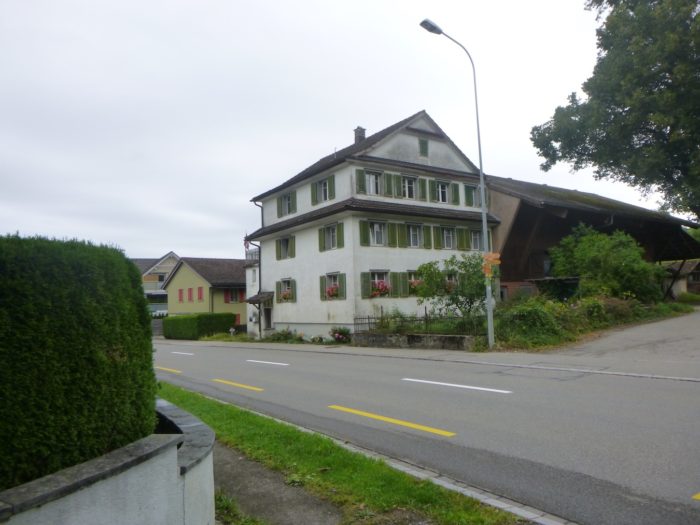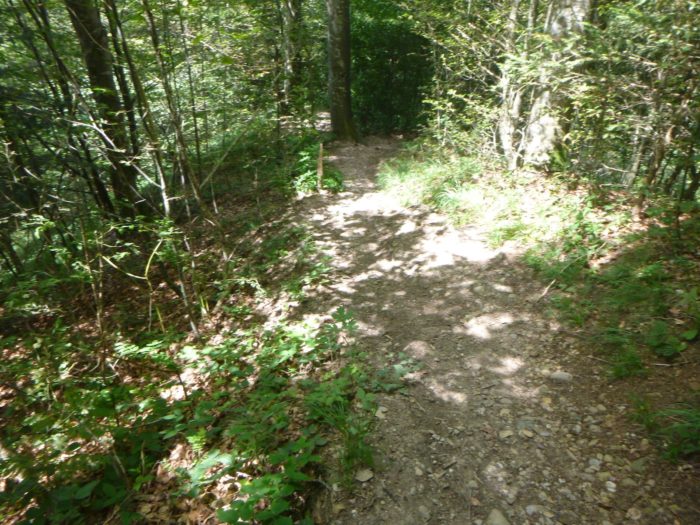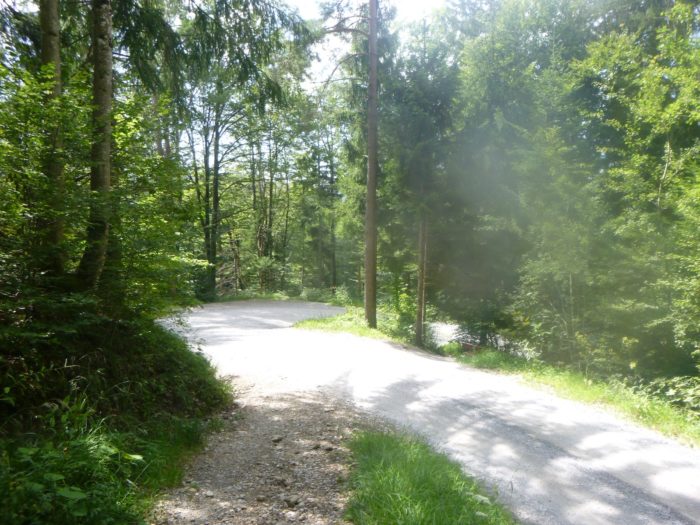Passing by the delightful Hörnli Mountain
DIDIER HEUMANN, ANDREAS PAPASAVVAS
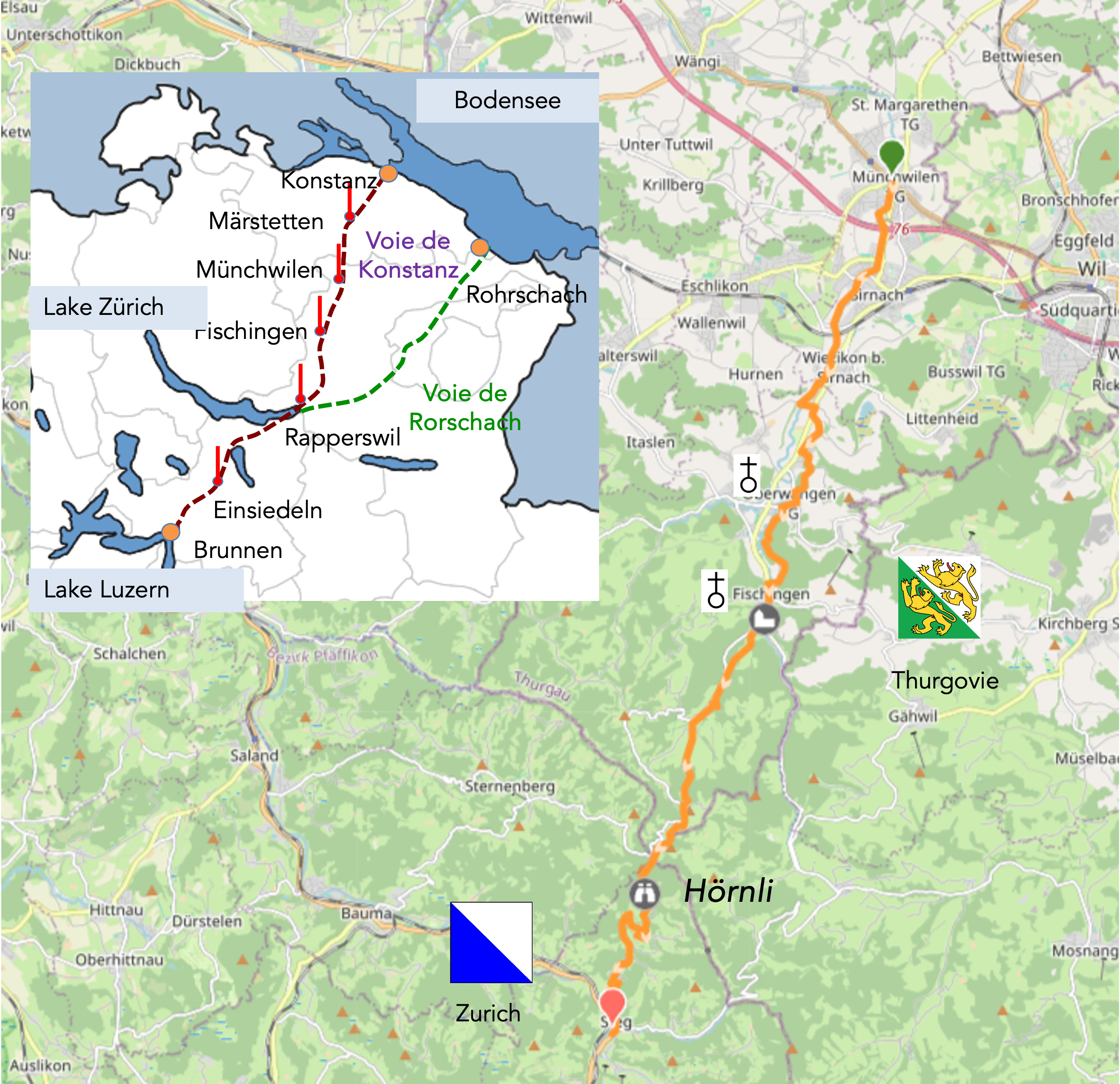
We divided the course into several sections to make it easier to see. For each section, the maps show the course, the slopes found on the course, and the state of the route (paved or dirt roads). The courses were drawn on the « Wikilocs » platform. Today, it is no longer necessary to walk around with detailed maps in your pocket or bag. If you have a mobile phone or tablet, you can easily follow routes live.
For this stage, here is the link:
https://fr.wikiloc.com/itineraires-randonnee/de-munchwilen-a-steg-im-tosstal-par-la-via-jacobi-4-153050550
|
Not all pilgrims are necessarily comfortable using GPS or navigating routes on a mobile device, and there are still many areas without an internet connection. For this reason, you can find several books on Amazon dedicated to the major Via Jacobi 4 route, which runs through the heart of Switzerland and over the Brünig Pass. The first guide leads pilgrims through the German-speaking part of Switzerland up to Fribourg, while the second continues through French-speaking Switzerland to Geneva. We have also combined these two books into a compact, lighter, and highly practical version. While the descriptions have been slightly condensed, they remain detailed enough to guide you step by step along the way. Recognizing the importance of traveling light, this latest edition has been designed to provide only the essentials: clear and useful information, stage by stage, kilometer by kilometer. The stages have been carefully adjusted to ensure accessibility and alignment with available lodging options. These books go beyond simple practical advice. They guide you kilometer by kilometer, covering all the crucial aspects for seamless planning, ensuring that no unexpected surprises disrupt your journey. But these books are more than just practical guides. They offer a complete immersion into the enchanting atmosphere of the Camino. Prepare to experience the Camino de Santiago as a once-in-a-lifetime journey. Put on a good pair of walking shoes, and the path awaits you.
|

|
 |
If you only want to consult lodging of the stage, go directly to the bottom of the page.
Over the centuries, the geographic map of Thurgau has been reshaped under the influence of the Zähringen lords, the Dukes of Freiburg, and the Counts of Kyburg, whose territorial imprints have shaped the landscape during the Middle Ages. It is hard to imagine today that Zurich was once enclosed within the canton of Thurgau. Yet, this is the captivating history of the region. In the late 13th century, the decline of the Kyburg dynasty opened the door to the Habsburgs, who had already seized much of what is now Switzerland. This historical episode, just before the dawn of 1291, marks the beginnings of the Swiss Confederation. The 15th century saw Thurgau become a fiefdom shared between the cantons of Zurich, Lucerne, Uri, Schwyz, Unterwalden, Zug, and Glarus—a time when the region was constantly tossed between diverse interests, leaving many tears in its wake. Then came the Reformation, during which monasteries were plundered before the Protestant wave swept over the region. In 1798, Thurgau officially became a canton of the Helvetic Republic, later fully integrating into the Swiss Confederation in 1803 following the « Act of Mediation » dictated by France. Ah, those French, driven by their tireless desire to meddle in the affairs of the world!
This tale of tumultuous historical events highlights the numerous rivalries between Thurgau and Zurich over the centuries. Thus, when you reach the majestic summit of the Hörnli, perched in the canton of Zurich but once embracing Thurgovian lands, there will be much to ponder! The Hörnli, a proud peak at 1,132 meters, stands on the lands of the commune of Fischenthal in the canton of Zurich, but the challenging ascent from Fischenthal plunges you into the depths of the canton of Thurgau. Just a few steps from the Hörnli, the canton of Thurgau reaches its highest point at Hofgrat, at 991 meters above sea level. However, a careful look at the map would also reveal the claims of St. Gallen on these territories. The wooded hills of the three cantons, despite their modest elevation, challenge climbers with their steep slopes, offering an experience that is sometimes exhilarating, sometimes grueling, depending on the pace of your joints. At the summit, on a clear day, a breathtaking panorama unfolds. In the Middle Ages, the Schwabenweg, or Swabian Way, a pilgrim route to Santiago de Compostela, wound its way through these lands. Since 2008, it has been incorporated into the route of the Via Jacobi 4, adding a new dimension to this history-laden landscape.

Difficulty level: Today’s journey presents very significant elevation changes (+729 meters / -545 meters). The first part of the route is fairly easy, with a pleasant walk along the river. However, once you reach Oberwangen, the challenges begin. First, there’s a substantial hill before Fischingen, followed by the ascent of Hörnli Mountain, a true thorn in the side, with some extremely steep slopes. But even at the summit, your day is far from over, as the descent to Steg im Tösstal is steep and treacherous.
State of the Via Jacobi: In this stage, the paths clearly dominate, especially as you approach Fischingen:
- Paved roads: 6.4 km
- Dirt roads : 13.3 km
Sometimes, for reasons of logistics or housing possibilities, these stages mix routes operated on different days, having passed several times on these routes. From then on, the skies, the rain, or the seasons can vary. But, generally this is not the case, and in fact this does not change the description of the course.
It is very difficult to specify with certainty the incline of the slopes, whatever the system you use.
For those seeking « true elevations » and enthusiasts of genuine altimetric challenges, carefully review the information on mileage at the beginning of the guide.

Section 1: Stroll Along the Murg

Overview of the route’s challenges : a route with no particular difficulty.

|
In the heart of the valley, where the Murg murmurs its aquatic melody, the Via Jacobi begins its journey from Münchwilen, with a promise of discoveries on the horizon. After a reflective two-hour and fifteen-minute walk, you will arrive in Fischingen, where the ancient cloister, a witness to centuries past, stands guard over the route like a sentinel of stone and faith.
|
 |
 |
|
The hiker follows the winding course of the river, where the water sings against the stones, passing in the shadow of the Protestant temple. This place, steeped in history, evokes a past where religious division was etched into the very stones of sacred buildings. Until 1933, a strange spiritual dance played out here, where Catholics and Protestants shared the same place of worship in a coexistence marked by tension and shared faith. This bygone era saw the Catholics of Münchwilen erect their own sanctuary, closely followed by the Protestants, marking the landscape with their determination for spiritual independence. Thus, in this corner of Switzerland, sacred architecture bears the recent scars of these separations.
|
 |
 |
| The journey continues, passing through a neighborhood where modern villas stand as witnesses to recent developments in housing, until the route crosses a crossroads, a symbol of the choices and directions the region offers. |
 |
 |
Shortly after, the Via Jacobi ventures into a verdant haven where the river continues to play its symphony.
|
 |
 |
| This park, a space of breathing and life, seems to be a favorite spot for the locals. Here, designated areas invite rest and contemplation, offering a welcome pause to the pilgrim or wanderer in search of serenity |
 |
 |
| Finally, the route reveals a road, a symbol of the continuation of the journey, between shadow and light. |
 |
 |
| In the heart of this green setting, the park unfolds like a living painting, where each brushstroke reveals a harmony of colors and textures. In the center, a peaceful lake, like a silver mirror under the gentle caress of the sun, is adorned with a myriad of water lilies. These aquatic flowers, true floating jewels, sketch ephemeral patterns on the water, inviting calm and contemplation. On the periphery, playgrounds burst with life, resonating with the crystalline laughter of children who dance there, while a swimming pool, bathed in light and reflections, promises a refreshing oasis under the azure sky. |
 |
 |
| Not far from this tranquility, the highway traces its route like a steel artery pulsing to the incessant rhythm of the modern world, a line on the horizon singing the call of urban adventure. Alongside it, almost in a whisper, the Via Jacobi discreetly weaves under a tunnel, embracing the shadow and coolness, following the river with the tenderness of a shared secret, like a silent vein. |
 |
 |
| The Murg, with its whims and leaps, weaves its liquid song through the landscape, a natural guide to lands where trade and industry sketch their own mechanical ballet. The gravel path, like Ariadne’s thread, weaves its way through the urban mosaic of the suburbs, where life pulses strongly, far from the preconception of a deserted region. In the canton of Thurgau, the hearts of some 270,000 souls beat, making this land the twelfth demographic jewel of Switzerland. |
 |
 |
| Your journey continues, flirting with the edges of the industrial zone, where the hands and minds of men and women shape the future in light and sound, within the walls of their workshops. This landscape, marked by the seal of progress, is drawn in vibrant contrast to the calm of natural landscapes… |
 |
 |
| …before fading beneath a road, where the path once again finds serenity along the river, in an intimate dialogue between stone and water. This passage, like a breath of life, symbolizes the meeting between the natural world and human imprint, a fragile and precious harmony. |
 |
 |
| You then reach the gates of Sirnach, a prosperous and lively commune where the echoes of the daily lives of its 7,900 inhabitants resonate. At the heart of the Münchwilen district, this town bustles like a nerve center where aspirations and dreams converge. Although your path, true to its discretion, prefers to avoid the beating heart of the town center, the contours of Sirnach stretch on either side of the Murg, the river that shapes its landscape. Wooden bridges, like open arms, span the water, inviting travelers to cross its waters and explore the secrets of each shore. |
 |
 |
| Further on, a large bridge allows you to cross from one side of the town to the other. |
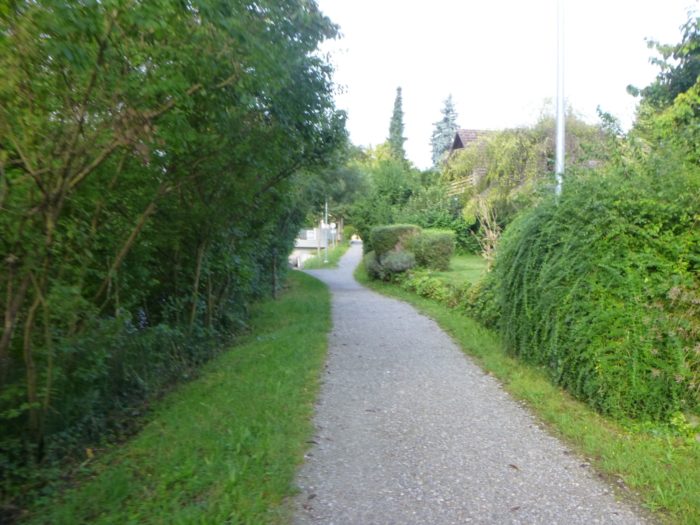 |
 |
A directional sign indicates that there are apparently two routes to reach Fischingen: one takes 1h50, the other 2h15. There’s no suspense here. For you, it will be 2h15. Only the Via Jacobi 4 is the definitive track.

| Continuing on your journey, the path always hugs the river, weaving through the outskirts of Sirnach, often hidden behind the sad hedges of thuja trees. |
 |
 |
| Soon, the silhouettes of factories rise on the horizon, guardians of progress and innovation. The landscape transforms, evolves, revealing the many facets of modern life, from residential areas to industrial zones, from fertile fields to steel and concrete infrastructures. |
 |
 |
| In this changing environment, the landscape gradually transforms, and the path winds between green meadows and cultivated fields, gradually revealing the outlines of Büfelden. |
 |
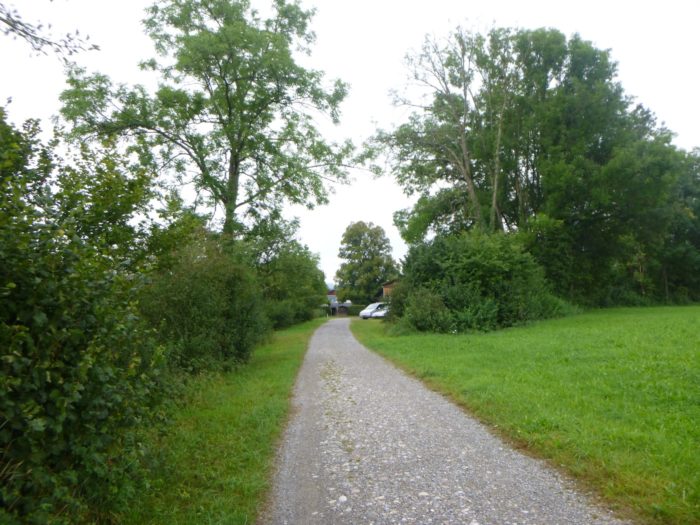 |
| And it is in this constantly evolving setting that the Via Jacobi enters the village, winding through the recent residential neighborhoods. Here, the houses have lost their beautiful half-timbering and settle for plastic shingles. However, care is evident everywhere. |
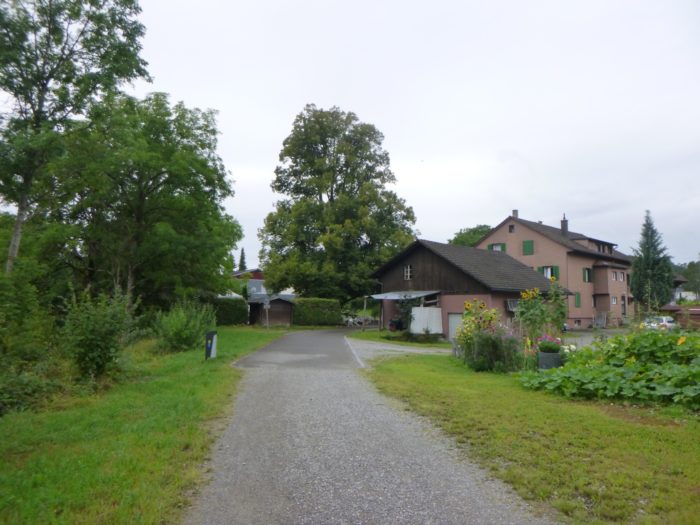 |
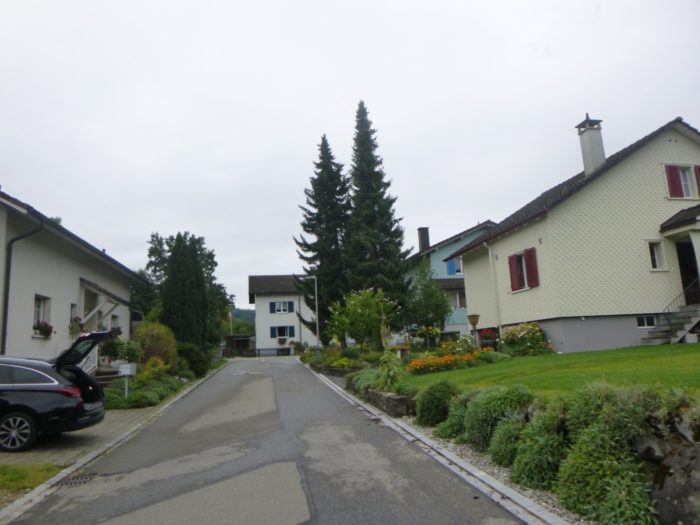 |
After nearly two hours of walking to Fischingen, your destination remains distant, a promise and its mysteries.

| Shortly after, a trail slips under the cantonal road along the river. |
 |
 |
| Barely have you left the protective shadow of the cantonal road when the landscape transforms, shedding human agitation to reveal its true wild essence. It’s a canyon sculpted by time, where the river rushes with force, creating tumultuous whirlpools in the crystal-clear waters. The tree canopies intertwine above you, forming an emerald arch under which you advance, lulled by the melodious rustling of leaves in the breeze. The river, a faithful companion on your journey, plays with obstacles, dancing between rocks with the grace of a woodland nymph, while the dark undergrowth exhales an intoxicating scent of damp earth and old mosses. |
 |
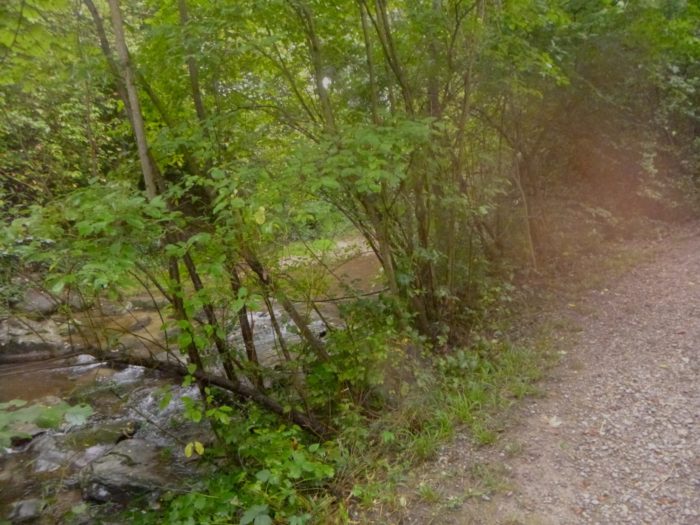 |
| The river, like a capricious artist, sketches arabesques on the bed of polished pebbles. Nearby, a hill emerges from the waves of greenery. Wooden steps, worn by the elements, lead you above, near a bridge that allows you to cross the river. But it is not for you. The river will still and always be on your left. |
 |
 |
| The trail then winds through a more serene landscape, where meadows stretch out. Yet, inexorably, it leads you to the other side of the river. |
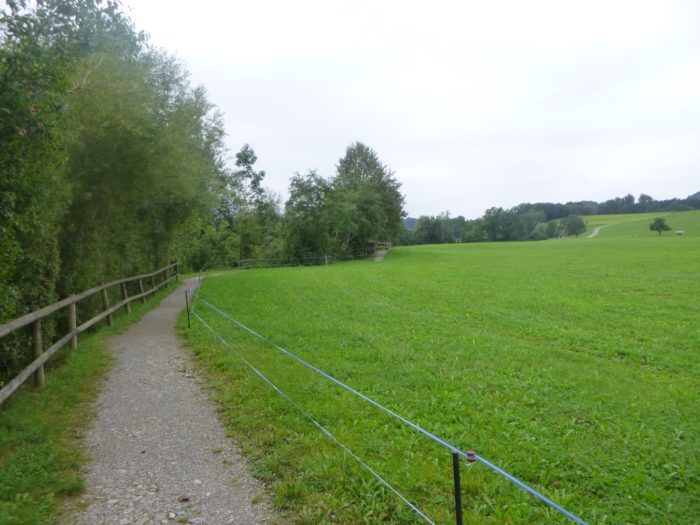 |
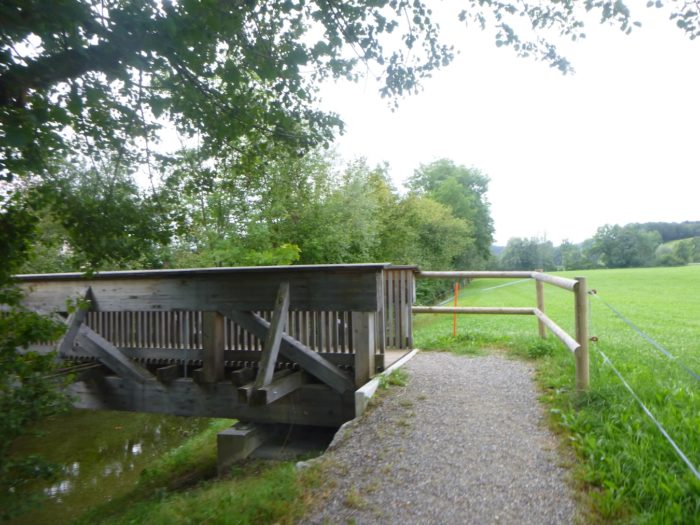 |
| There, a scene full of tranquility and charm unfolds. The teasing waters of the river dance in the meanders of a majestic canyon, creating a captivating wild symphony. On the other side, an enchanting lake invites contemplation. The Via Jacobi, true to its course, follows the welcoming contours of the small lake. Observing the layout of the area, it’s easy to imagine that fish farming finds its ideal spot here. In this landscape where nature seems to have orchestrated every detail with exquisite precision, the traveler cannot help but marvel at the harmony that emanates from this green haven, where shadow and light, calm and tumult blend harmoniously. |
 |
 |
| On the other side of the lake lies Wiezikon bei Sirnach, a village ignored by the Via Jacobi. |
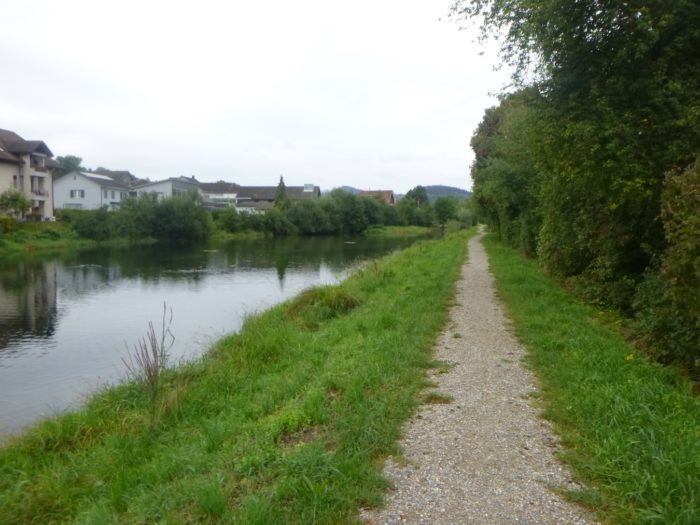 |
 |
Section 2: From one forest to another

Overview of the route’s challenges: often significant ups and downs.

| In Wiezikon, you are 1 hour and 20 minutes away from Fischingen. The Via Jacobi will once again meet the banks of the Murg, that majestic and unwavering river that murmurs and sets the rhythm of the region’s secrets. |
 |
 |
| In this part of your journey, solid ground gives way to the road, a symbol of civilization and progress. The road, like an asphalt vein, winds at your feet, while the Murg, the faithful companion of your journey, continues to stroll on your left, hidden behind deciduous hedges, a silent guardian of the surrounding tranquility. |
 |
 |
| Your gaze gets lost in a charming tableau where meadows stretch out as far as the eye can see, caressed by the light breeze and the whisper of time. In the distance, fields of corn sway gracefully, reflecting in the calm waters of the Murg, offering a symphony of shades and contrasts. The corn, when it does not cover endless hectares, remains a restful sight. |
 |
 |
| As you advance, the path becomes a new companion to your steps, drawing you imperceptibly closer to the river, which sets the pace of your progress. |
 |
 |
| But soon, as if to better surprise you, you cross the river again. The Murg leaves you and vanishes behind the hills that line the horizon. You leave behind its soothing murmur, yet you follow the trail of its course, sailing on the invisible waters that irrigate this valley. |
 |
 |
|
A wide gravel path confidently winds through the green hills to the village of Wies. It is here, in the heart of this valley, that the rustic soul of the land reveals itself in its true nature. In this farming village, time seems to flow with the seasons, in harmony with the nurturing earth that surrounds them.
|
 |
 |
From the village, the Via Jacobi follows the main road for a few hundred meters as it heads towards Fischingen. Throughout this journey, ancestral farms punctuate the landscape, bearing witness to the toil of the land. .
|
 |
 |
But soon, as if to better blend into the living canvas of nature, the Via Jacobi veers off the main road, taking a humbler road where green meadows and gently swaying cornfields unfold.
|
 |
 |
| And as the road stretches out before you like an invitation to adventure, you quickly arrive at Anwil, another rustic village nestled in the heart of these fertile lands. Here, the air is fragrant with the scent of freshly plowed earth, while crosses, silent witnesses of a faith rooted in the soil, punctuate the landscape with touching solemnity. The crosses become more prominent in a canton where Protestantism does not hold complete priority. |
 |
 |
| The road draws closer to the forest, and further on, a trail climbs into the woods, like an irresistible invitation to explore the unknown. |
 |
 |
| As you enter this dense and mysterious undergrowth, a muffled ambiance settles in, enveloping your senses in a gentle darkness. The trees stand like silent sentinels, guardians of their millennia-old mysteries. |
 |
 |
| Yet, you hardly have time to linger in this enchanting darkness. No sooner have you set foot in this thick forest than it already pushes you back, thrusting you towards the edge where the housing developments of the hamlet of Bürglen spread out like oases of light and civilization. |
 |
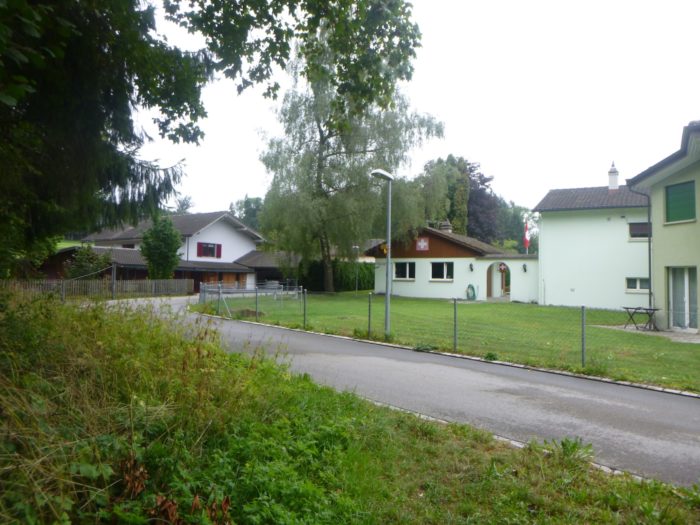 |
| Here, you won’t miss a most unusual encounter: the whimsical appearance of a hippopotamus, lounging with surreal nonchalance in the garden of a house marked by the quirky character of the region. It is here, in this peculiar corner of the land, that the creative madness of the inhabitants flourishes in all its splendor, defying conventions and expectations. |
 |
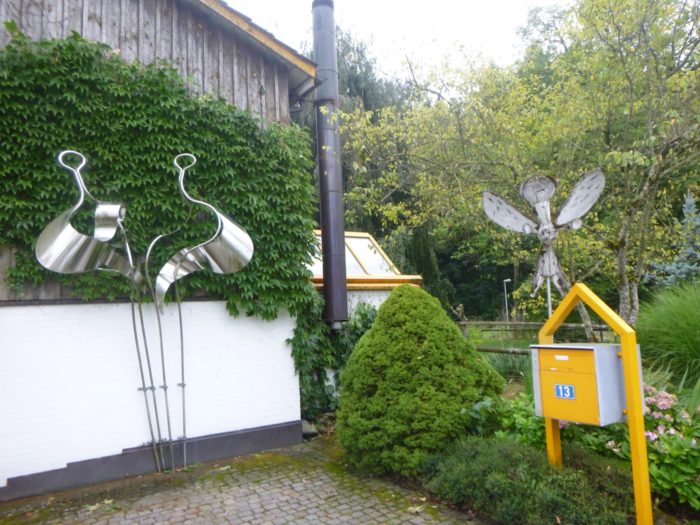 |
| As you leave Bürglen, the asphalt stretches its black ribbon, inviting travelers to venture even further into the mysteries of the countryside. It is here that the dance between the man-made world and the nature surrounding it begins—a harmonious symphony of toil and vitality. In this region, as is often the case in the Swiss hills, forests are not forgotten sanctuaries but dynamic ecosystems, where each tree plays a role in the grand theater of human and wild life. |
 |
 |
| Further along, the Via Jacobi breaks away from the monotonous asphalt to gracefully slope up through the meadows, its stone steps leaving an ephemeral imprint on the swaying grass. The woods welcome the hiker with open arms, offering a reassuring refuge from the world’s hustle and bustle. |
 |
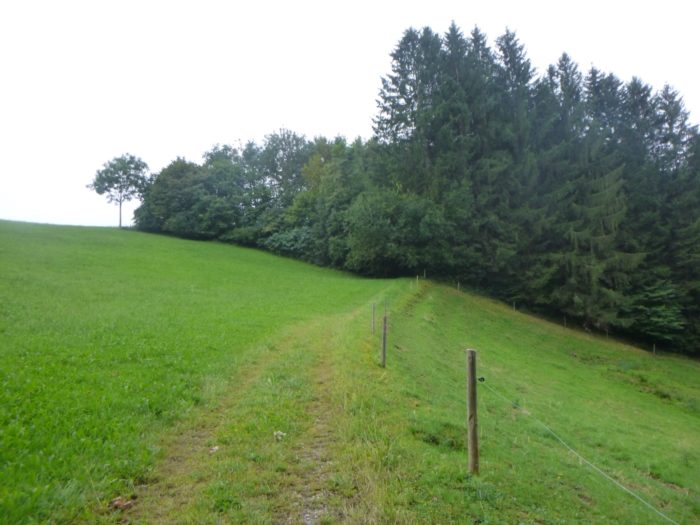 |
In the German-speaking part of Switzerland, the meadows stretch as far as the eye can see, a dazzling green canvas that might almost make the peaceful cows grazing on these fertile lands blush with envy. Every blade of grass seems imbued with the richness of the earth, while the rolling hills bear witness to the passage of time, silent guardians of centuries of toil and love for the land.

| Tre trail slopes up in the dense undergrowth, where beeches and maples stand in majesty, spruces crowd together, creating a secret world where light struggles to pierce the darkness. Like souls seeking freedom, some trees strain under the weight of their neighbors, while others reach towards the sky in silent jubilation. |
 |
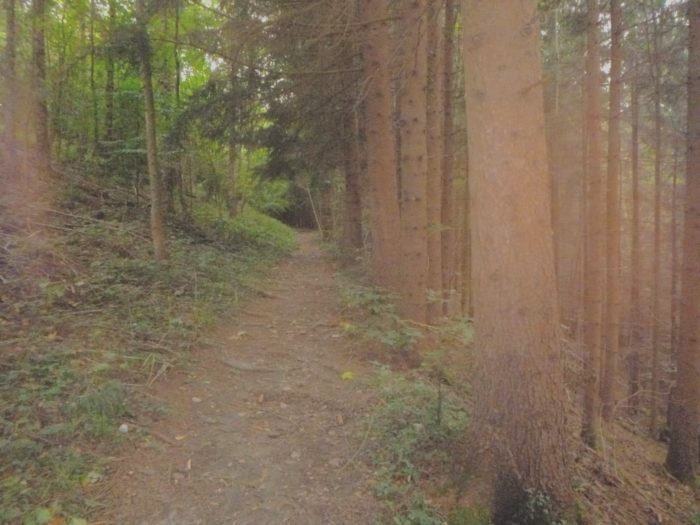 |
| Shortly after, a glimmer of hope breaks through the thickness of the woods, where a few lucky spruces finally breathe the pure air of freedom. It is here, in this striking contrast between oppression and freedom, that the poetry of nature resides, a hymn to resilience and the beauty of life. |
 |
 |
| And then, like the whisper of a storyteller revealing his final secrets, the trail continues its descent, widening into a path that disappears into a forest where shadow and light dance their eternal waltz. |
 |
 |
| At the edge of the forest, a winding road unfurls like a ribbon towards the picturesque village of Oberwangen, where the proud silhouette of its chapel stands, evoking more of a sanctuary of tranquility than just a religious building. Oberwangen, closely tied administratively to Fischingen, breathes the authenticity of a land where cattle and trees have always been the faithful companions of its inhabitants, once supported by the delicate art of embroidery. History is etched in the stones, the streets, and especially in the St Martin Chapel, erected in the 10th century and later embellished with a majestic dome in the 18th century, an immutable testament to a faith rooted in time. |
 |
 |
Fifty minutes from Fischingen, this peaceful village is also a haven for lovers of skiing, as evidenced perhaps by the sign indicating a nearby ski lift.

| Just after leaving the village, the Via Jacobi crosses the lively waters of a tributary of the Murg, almost surprised to find itself so close to this watercourse. |
 |
 |
| The road, like a roller coaster, winds under the arches of the chapel before rising abruptly above the village in a significant ascent. Each turn, each bend, tells of the effort, offering below an unobstructed view of the rooftops and the verdant meadows. |
 |
 |
| Higher up, where the road gives way to a narrow path, the adventure continues through the woods overlooking the village, soon offering intrepid explorers a trail carved through the forest. |
 |
 |
| In this green setting, where time has stood still, darkness reigns supreme, while the steep slope beneath the majestic beeches and tightly packed spruces resembles a compact crowd holding its breath, like spectators captivated by the magic of a spectacle. |
 |
 |
| With every step, the forest’s embrace tightens, its secret whispers guiding travelers’ steps on rustic staircases, testaments to man’s struggle against untamed nature. Shortly after, the trail emerges at a fork, offering hikers two choices leading to Fischingen. Your route follows the direction of Chilberg, promising discoveries at higher altitudes. |
 |
 |
| But where the light struggles to penetrate the dense foliage, the bare trees raise their branches to the sky, their silhouettes sometimes resembling the delicate ridges of a fish. It is in this striking setting, where each tree seems to plead for grace in its quest for light, that the fragility and grandeur of nature are drawn. |
 |
 |
Section 3: A beautiful monastery before the mountain

Overview of the route’s challenges: The route often involves steep slopes, both uphill and downhill.

| Further along, as you take each step, the density of the forest seems to gradually give way, allowing the first rays of light to timidly filter through the foliage. |
 |
 |
| Like a promise of clarity after darkness, the trail appears to be on the verge of leaving the woods as it winds around a curious collection of pieces of wood arranged like treasures, evidence of the work of the loggers in these wild regions. |
 |
 |
| Shortly after, the path suddenly widens, exchanging the narrowness of the trail for the generosity of a broad dirt road that begins its descent from the hilltops. Under the feet of the travelers, the loose earth exhales a rich scent of soil and life, while the gentle slope invites an easier progression toward the valley below. |
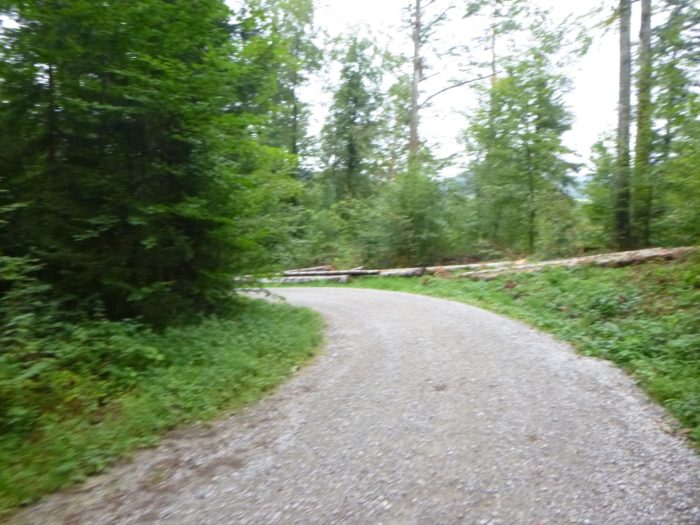 |
 |
And then, as if emerging from the green setting, Fischingen suddenly appears, with its monastery dominating the horizon like a beacon of serenity in the heart of the wild nature. In this bucolic landscape, where civilization seems to have found refuge within the ancient forests, the monastery stands as a symbol of peace and contemplation, offering lost souls a haven of tranquility amidst the world’s turmoil.

| A paved road, gracefully winding through the hills, begins its gentle descent toward the sleepy village, offering travelers a unique perspective on the tranquility reigning in these remote valleys. On its way, it passes by a specialized school, dedicated to teaching and supporting young people facing learning and behavioral challenges, an oasis of hope in the heart of the community. |
 |
 |
| As the road continues its descent, it inevitably approaches the entrance of the village, where the modest hustle and bustle of daily life seems to fade into the air. |
 |
 |
| The road crosses a village where the cheese dairy reigns supreme. |
 |
 |
 |
 |
|
And there, perched on an esplanade overlooking the road, stands the monastery, a majestic witness to an unwavering faith. With its imposing church, welcoming hospitality buildings, and the chapel dedicated to Santa Idda, the monastery reveals itself as an architectural jewel, resonating with the prayers and chants of the monks who have inhabited it for centuries. The presence of Santa Idda of Toggenburg, who lived near the monastery in the 12th century and whose funeral chapel rests near the church, adds a touch of holiness and mystery to this place steeped in spirituality.
The monastery, an unchanging witness to the passage of time and the evolution of beliefs, finds its roots in the distant mists of the 12th century when the Bishop of Constance, Ulrich II, laid the foundations of this sanctuary of piety. Designed in the tradition of double monasteries, it offered a spiritual refuge to both monks and nuns, with within it a large guesthouse intended to welcome souls in search of comfort. In the 13th century, the monastery reached its peak, housing a flourishing community of 150 monks and 120 nuns, each dedicating their life to prayer and service to God within the sacred walls of this spiritual enclosure. However, history took an abrupt turn in the 16th century when the winds of the Reformation blew through the region. In 1526, the abbot and the four remaining monks embraced the Reformed faith, leading to the temporary closure of the monastery and the departure of the Catholics who resided there. However, the Benedictine abbey was revived under the auspices of Catholic towns, as the voices of monks and nuns once again echoed through the silent corridors of the cloister. Despite these upheavals, the monastery remained a beacon of spirituality, now under the tutelage of the canton and the Confederation, thus bearing witness to the persistence of faith through the vicissitudes of history.
|
 |
 |
| During the 17th and 18th centuries, the monastery of Fischingen underwent an architectural renaissance under the influence of the Baroque and Rococo styles, reflecting the artistic trends prevalent in Germany and Eastern Switzerland. However, this reconstruction enterprise was not without its challenges, as numerous discussions and disputes arose around the project, particularly concerning funding, which remained a subject of discord until the end of the 18th century. At that time, the monastery was primarily populated by monk-priests, that is, members of the Benedictine order ordained as priests, among whom there were up to 134 individuals, most of them priests. After the death of the last Benedictine abbot in 1848, the monastery of Fischingen was abolished, and its buildings were handed over to a textile industry that began manufacturing cotton fabrics and shoe uppers. Later, the premises were transformed into an international business school, and then, from 1943 onwards, into an orphanage under the direction of Benedictine priests. It was only after the abolition in 1973 of the so-called « exception clause » of the Swiss Federal Constitution, which prohibited the construction of new monasteries and the restoration of those abolished, that the monastery of Fischingen was renovated into a Benedictine priory, a process that lasted until the end of the last century. |
 |
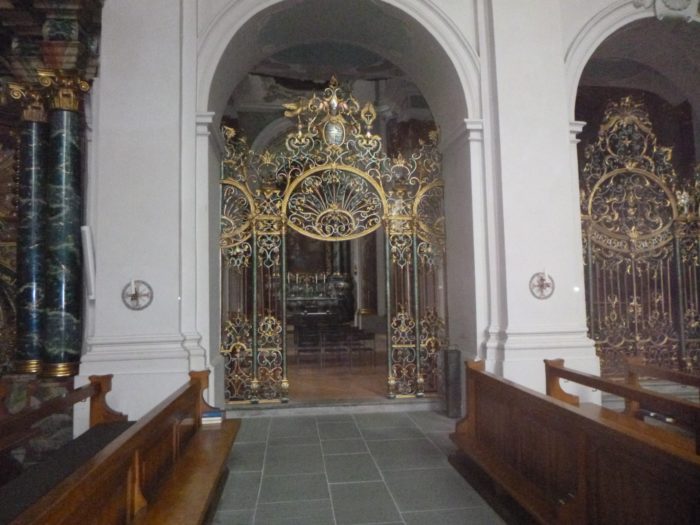 |
Today, the St Iddazell association owns the premises, and in addition to the specialized school, it manages a seminar hotel, a pilgrimage hostel for the Swiss Camino de Santiago, as well as a monastic brewery producing Pilgrim beer, an abbey beer, on par with Belgian beers, highly regarded in the country.
|
 |
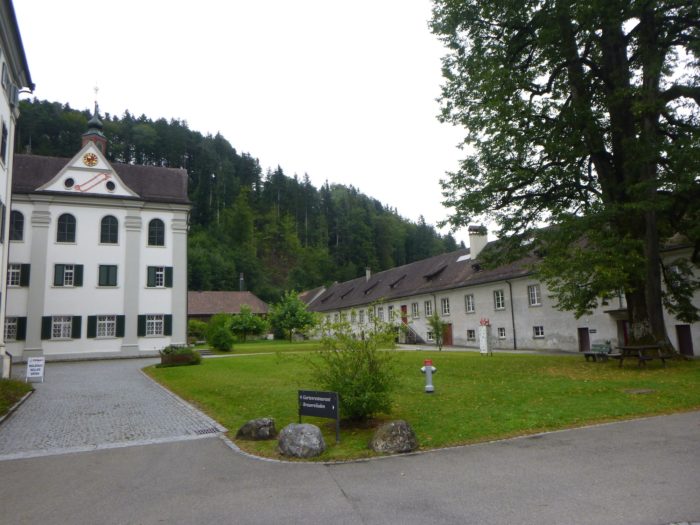 |
In this environment steeped in history and renewal, the signs indicate the proximity of the Hörnli mountain, about 2 hours of walking, and Steg, 3 hours away, offering travelers perspectives of more sporting adventures. But you must walk quickly to stay within the allotted time for this challenging course, both uphill and downhill.
|
 |
 |
| The Via Jacobi soon crosses the Murg stream again, leaving the main axis to follow a small paved road that winds behind the last houses of the village. |
 |
 |
| The road then crosses the discreet murmur of the Aubach stream, then climbs determinedly through green meadows, skirting the edges of the undergrowth. Here, the farmers display their handcrafted products, fruits of rural know-how, offering passersby a taste of local life. |
 |
 |
| At the top of this steep ascent, the slope levels out as it approaches Neuschür, where a few isolated farms and weathered wooden barns bear witness to the frugal life led by the farmers in these lands. |
 |
 |
| On the difficult climb toward the Hörnli mountain, the Via Jacobi then offers a welcome respite; the paved road flattens out, even descending slightly, winding through a forest rich in conifers, a tableau of white firs and spruces. Although less numerous, the deciduous trees manifest themselves through hazelnut trees, modest maples, and delicate hornbeams. |
 |
 |
| Further along, in the heart of the woods, the dirt road replaces the asphalt, enhancing the feeling of a return to nature. |
 |
 |
| In these woods, where majestic beeches and maples have taken over, the path reveals a welcoming picnic spot, a sweet pause for hikers. As is always the case in German-speaking Switzerland, wood is graciously provided, a sign of warm hospitality within this peaceful nature. |
 |
 |

| The walk becomes gentle, lulled by a peaceful atmosphere under the generous canopy of tall deciduous trees. The path, though somewhat rocky, remains pleasant, offering with each step the comforting sensation of walking in the shade, away from the scorching sun. The trees’ shadows form a beneficial veil, filtering the light and creating plays of shadow and light that dance on the rocky ground. The air is cool, almost damp, imbued with the invigorating scents of the surrounding forest. |
 |
 |
| However, as the walk progresses, the path seems to want to change character, as if it seeks to reveal another side of itself. It abandons the reassuring and familiar dirt road, delving into a more intimate, more secret trail that winds through the thick foliage. Here, nature seems to close in around the walker, enveloping them in a green cocoon where every rustle of leaves, every crack of a branch tells a forgotten story. |
 |
 |
| The trail, after flirting with the road that climbs toward Hörnli, suddenly veers off, as if taken by a capricious impulse. It turns left, leaving the obvious slope behind to discreetly cross the calm Bleikebächli stream. This modest and serene stream barely murmurs under the tree cover, adding a soothing note to this symphony of greenery. |
 |
 |
From the stream, the slope becomes steeper, and the forest changes tone. The deciduous trees gradually give way to conifers, their slender silhouettes standing like silent sentinels on the steep slopes.

| The climb becomes more demanding, and to overcome this difficulty, a few makeshift steps have been cut into the wooden logs, providing a precarious but welcome support for hikers. These steps, rudimentary yet effective, underscore the ruggedness of the terrain, while also bearing witness to human passage through this wild nature. |
 |
 |
| The subsequent descent is no less pronounced. It plunges once again into a dense forest, where the gnarled roots of trees intertwine with the path, making each step uncertain, as if inviting caution. The bold trail eventually crosses the stream with a name as enigmatic as it is unpronounceable for those unfamiliar with German: the Chappegghöllibächli. This stream, with such a low flow that it seems barely to move, adds to the strangeness of the place, like a secret whispered to the trees. |
 |
 |
| Shortly after, as if it finally wants to release the walker from this sylvan embrace, the trail clears up. It leaves the woods, finding the open sky again, to emerge at Au, a place where the light reasserts its dominance, where the horizon suddenly widens, offering a new breath to the hiker. |
 |
 |
| The hamlet of Au reveals itself, a small gem nestled on the road leading to Hörnli. It is a charming place, almost timeless, where traditions still seem very much alive. The church, with its modest bell tower, stands as the beating heart of this picturesque village, offering spiritual refuge to passing souls. Here, the travelers can refresh themselves, recharge before continuing their journey to the heights. |
 |
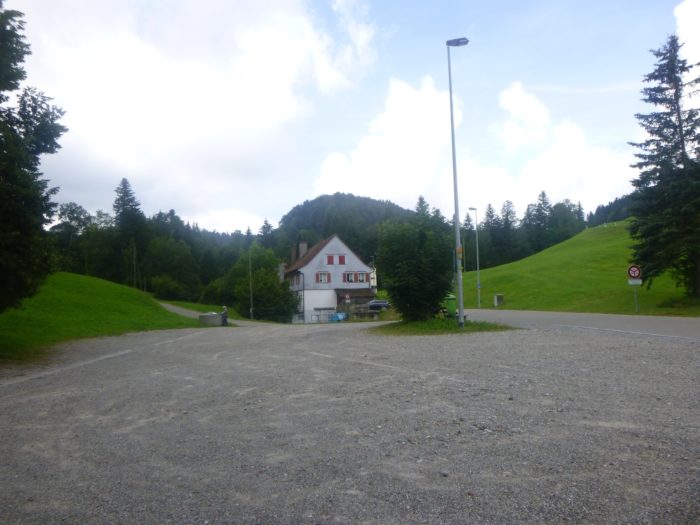 |
However, there is no direct road leading to Hörnli, this impasse perched at a high altitude. Hörnli seems almost unreachable, perched like a guardian watching over the valley. But the surrounding area compensates with a rich gastronomy, with numerous mountain restaurants favored by locals who know these places well. The road then stretches in multiple hairpin turns, hugging the contours of the landscape, winding through hills and forests to reach neighboring hamlets like Schwendi or Allenwinden, each turn offering new perspectives.

| In Au, you are already at an altitude of 690 meters. The summit of Hörnli, with its 1133 meters, seems almost inaccessible from this point, but it is nonetheless your next destination. You will need to draw on your energy reserves to reach this steep hill, which is not a true mountain. Before that, Allenwinden, a 45-minute walk away, will be your first objective, while Hörnli itself is about an hour and a half walk. Each step brings you closer to this coveted summit, but the route remains long and demanding. |
 |
 |
| At the exit of the hamlet, signs announce the presence of inns. However, not all are on your route, and some, due to the seasons or time, are no longer open regularly, or have even permanently closed their doors. This realization adds a touch of melancholy to the landscape, reminding that even the most picturesque places are not immune to the passage of time. |
 |
 |
| Behind the last houses of Au, where stalls display artisanal trinkets, evidence of local craftsmanship, the road regains its vigor. It climbs abruptly, becoming more severe, almost uncompromising, like a challenge to the walker. Each step becomes harder, each breath deeper, but the promise of the mountain, up there, continues to irresistibly attract. |
 |
 |
Section 4: Up there at Hörnli Mountain

Overview of route’s challenges: The route is challenging, with steep inclines.

| The gradient is unforgiving, with a daunting slope nearing 20%. This road, seemingly determined to conquer the heights with fierce resolve, climbs a round, verdant hill, winding through meadows like an unrelenting serpent. It is one of those high alpine landscapes where nature, though bare and austere, possesses a raw beauty that captivates the soul. You can only grow weary under the strain, sweat beading on the forehead, in this setting that is both harsh and divine. |
 |
 |
| After navigating the tight turns that shape the road with the precision of a brush on a canvas, you’ll catch sight of the Vorder-Aderwil farms nestled higher up. These buildings, appearing to hang between sky and earth, oversee the view like silent sentinels of this rural world. |
 |
 |
| In this postcard-worthy scene celebrating Swiss alpine meadows, only scattered farms are visible, like rare pearls on a bed of green. Here, the farmers do not live in opulence; rather, their existence seems rhythmically aligned with the seasons, marked by austere simplicity. |
 |
 |
| Yet, everything here breathes beauty and harmony. The wooden chalets, weathered by the years and elements, blend seamlessly into the landscape, testifying to an intimate dialogue with time and nature. How beautiful, yet harsh, the life of these isolated peasants at the end of the world must be! |
 |
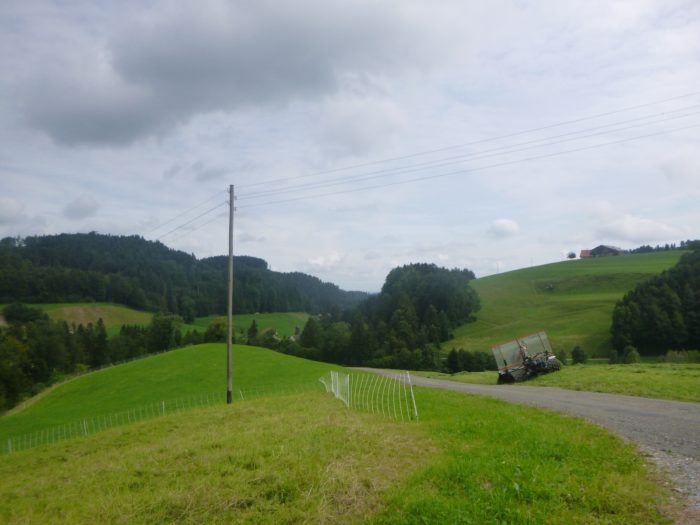 |
| One of the unique aspects of daily life in Thurgau, inherited from the Reformation, is the « simultaneum » — the balanced coexistence of the two major Christian denominations. Thus, religious symbols, particularly Catholic crosses, dot the landscape as silent witnesses to a shared history. |
 |
 |
| From this peaceful hamlet, the road continues its relentless ascent until it transitions into a dirt path. In the shade of majestic beeches, maples, and towering conifers, this path seems to gently fade into the coolness of the undergrowth. |
 |
 |
|
As you traverse such rugged and sublime landscapes, an inevitable question arises: how do these farmers, clinging to their hills like birds to their nests, manage to survive in this almost untouched nature, where everything seems both hostile and enchanting?
|
 |
 |
|
The dirt road climbs inexorably until it transforms into a narrower trail, quietly venturing into the depths of the forest like an invitation to uncover hidden secrets.
|
 |
 |
|
Here, you face a climb that promises to be a true challenge, a steep ramp of stairs rising boldly with a vertiginous slope nearing 50%. The distance is short, but do not be deceived: each step is a trial, a battle against gravity. Fortunately, safety barriers, like benevolent sentinels, guide and support you in this intense effort. You only have a hundred steps to ascend, but the climb demands unwavering strength and determination from you.
|
 |
 |
At the top of this ramp, the slope remains relentless. The trail, far from easing, is now strewn with roots and rocks, natural obstacles that seem intent on testing your endurance.
|
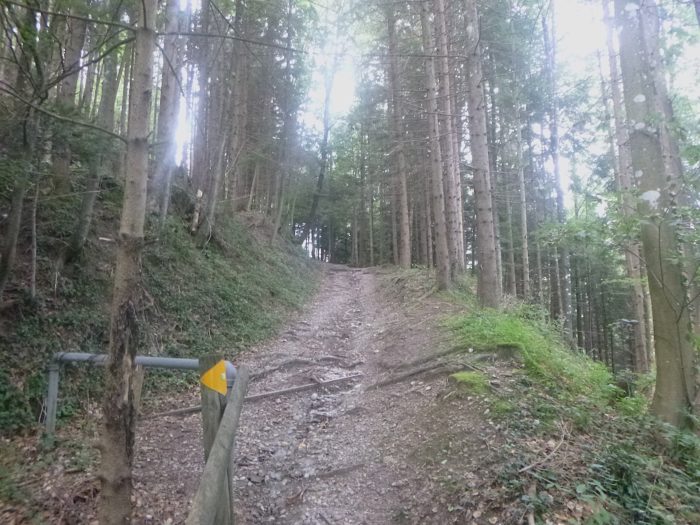 |
 |
In this mixed forest, where a silent battle for light and space is waged, the pines and maples stand tall with a defiant height over other conifers. Here, a notable feature of the Camino de Santiago emerges: the white firs, normally rarer, outnumber the spruces. This is not a matter of altitude, as these two species, like reluctant neighbors, coexist even in high mountains. The reasons are manifold: climatic whims or perhaps the actions of past humans who, by planting these trees, have altered this landscape.
|
 |
 |
| Once again, a flight of stairs presents itself, less severe than the previous one, allowing you to catch your breath. Here, at the height of the trunks, which the lumberjacks have carefully arranged with passion, the forest seems to hold its breath along with you. |
 |
 |
| Finally, the slope eases, becoming more forgiving with a gentler incline of about 10%, in this forest where the trees are spaced out, letting light filter through. |
 |
 |
| The conifers and deciduous trees, deprived of light at their bases, shed their lower branches while their crowns brush against the sky, like a sea of greenery where the trees, pressed close together, reach towards the infinite like a shoal of sardines crammed into a tight space. |
 |
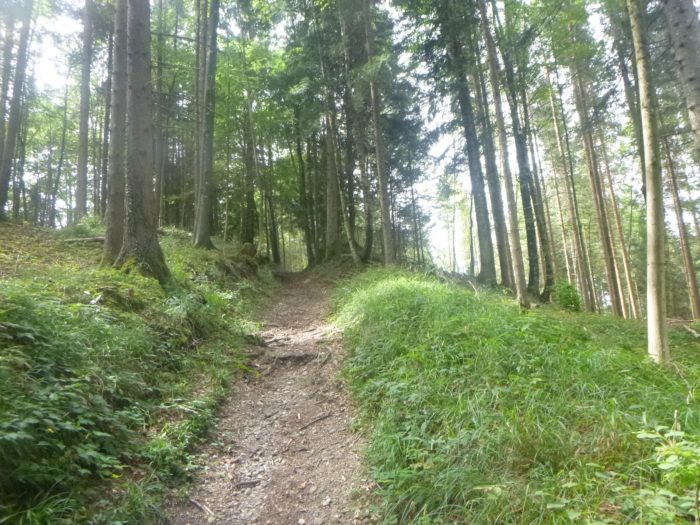 |
| Higher up, the trail reaches a plateau where the forest finally seems to retreat, where the forest seems to finally retreat, revealing isolated farms scattered beyond the trees. The landscape that unfolds before you is breathtakingly beautiful, a scene where nature, in all its splendor, seems to whisper secrets to those who know how to listen, leaving you with a tingling sensation, as if the earth itself is vibrating beneath your feet. |
 |
 |
| The trail suddenly reveals itself, emerging from the dense shadow of the undergrowth into a clearing of striking beauty. |
 |
 |
| Here, the countryside, with its peaceful settings, reclaims its rights, bringing you back to a simplicity that touches the essence of rural life. Sheep, like placid guardians, punctuate the scene with their presence, offering a pause in the relentless flow of the path. The trail then begins to descend vigorously, tilting boldly as if it wants to merge with the earth, leading down to a forest road below. This road, appearing to come from nowhere, originates in the hamlet of Au, winding through the woods with tranquil persistence before courageously climbing the steep slopes leading to Allenwinden. |
 |
 |
| The ascent resumes, harsh and relentless, as if the road itself is challenging travelers, pushing them to surpass themselves to reach the meadows of Allenwinden. Each step becomes a struggle against gravity, an effort rewarded by the gradually revealed splendor of the landscape as you climb. |
 |
 |
| There was a time when the Kreuz restaurant, nestled in Allenwinden, was a must-stop for all Hörnli enthusiasts, those local hikers and excursionists seeking rest and comfort. With its sunlit terrace, child-friendly space, and a breathtaking view over the valley stretching infinitely, it was more than just a break; it was an experience etched in the memory of all who visited. But today, the curtains are drawn, and since 2011, the Kreuz has remained desperately closed. No one knows for certain if this place, full of memories and conviviality, will ever reopen. The challenges are numerous for keeping such a business alive, and in this remote area, the whims of time do little to ease the task. On rainy days, almost no one ventures here, except for a few solitary pilgrims, fleeting shadows in the mist. Conversely, when the sun shines, the restaurant was literally overrun, with customers flooding the place, making it almost unrecognizable. The flow was so irregular that it became almost impossible to find staff willing to accept such unpredictable hours, swinging between the bustle of sunny days and the heavy calm of rainy ones.
You now cross the invisible boundary between two worlds: that which separates the canton of Zurich from Thurgau. The much-anticipated destination, Hörnli, is still 50 minutes away on foot, a prospect that is both encouraging and intimidating. Although the altitude here is only 913 meters, the summit reaches 1113 meters, reminding you that the effort is not yet over. |
 |
 |
| A winding mountain road stretches towards Kalterbrunnen, where the landscape transforms, revealing agricultural practices from another era. Here, turkey farming dominates, an activity reflected in the sale of the meat, where the cycle of life follows its relentless course without a false note. |
 |
 |
| The Via Jacobi, true to its tradition, continues along the paved road a bit further, but soon deviates, leaving the hardness of the asphalt for the softness of a wide dirt path. This path sneaks discreetly behind the last farm of the hamlet, as if to escape the modern world and reconnect with wilder, more authentic nature. |
 |
 |
| Here, the Hörnli mountain inn is announced, promising a well-deserved rest, a haven for weary souls. |
 |
 |
| The climb resumes, harsh and uncompromising, on this dirt road where the gravel shifts under each step, emitting a squeaky complaint beneath the hikers’ soles. The surrounding environment is bare, almost austere, marked only by the silhouette of a solitary reservoir, an incongruous element that accentuates the sense of effort. The landscape, though magnificent, does not yield easily. Each step seems heavier than the last, and the road unfolds like an endless challenge, etched in stone. |
 |
 |
| At the end of this relentless ascent, a bench stands, humble yet providential, ready to offer rest to travelers. It is there, like a fulfilled promise, a haven for weary bodies, a reminder that every hardship finds its relief. |
 |
 |
| From this vantage point, the view reveals itself in all its splendor. The Thurgau hills stretch as far as the eye can see, like an ocean of endless green, covered in vast, gigantic forests where the gaze can wander. Here and there, hamlets appear, perched on ridges, defying gravity, silent witnesses of a harmony between man and nature that seems from another era. The eye embraces this expanse and feeds on every detail, every nuance. |
 |
 |
| After the effort comes respite. The path, at last, becomes gentler, winding softly through the forest. It meanders between trees, playing with shadows, offering the hiker a moment of tranquility, an opportunity to catch their breath. It is a moment stolen from the harshness of the journey, a breath that nature generously grants. |
 |
 |
| But this tranquility is only temporary. The path does not linger under the tree cover and soon stretches out again over the meadows. There, the bells of Braunvieh cows softly ring in the air, their slow and regular jingles composing a rustic melody. The cows, with their large placid eyes, follow you with their gaze as if to gauge your determination, adding a touch of life to this pastoral scene. Their presence is soothing, almost meditative, anchoring the hiker in the present moment. |
 |
 |
| From this open clearing, the antenna crowning the top of the Hörnli finally appears, standing like a beacon towards the sky. At first glance, it seems within reach, so close, so accessible, that one might think the hike is over. But this is the trick of the mountains: they deceive the eye, promise, and then recede, a constant play of distances and heights. The summit always seems to move farther away as you approach. |
 |
 |
A few steps further, the path leads to a place called Silberbüel, a clearing suspended at 980 meters altitude. The illusion of the antenna’s proximity dissipates: there are still over a hundred meters to climb. It is just a reminder, a final challenge, that even at the threshold of the destination, the mountain grants nothing without a struggle. The last act of this ascent is about to unfold, and the hiker, seasoned yet still humble before the grandeur of nature, must prepare for this final effort.

| Just above, the path winds to a place called Dreiländerstein, a name evoking the meeting of three distinct worlds: the cantons of Thurgau, St Gallen, and Zurich. An invisible border marks its lines, delineating territories that, nevertheless, seem to blend harmoniously into the landscape. The Hörnli mound rises, an unwavering witness to this triad, proudly anchored in the canton of Zurich. At the edge of the woods, a modest alpine chalet stands, like a sentinel of the seasons, opening its doors only on rare occasions, whispering of ancestral traditions. |
 |
 |
| Barely enough time to catch your breath before the slope intensifies, urging the walker to follow a winding path through the forest. The effort becomes urgent, each step a challenge, but the forest, like an enchantress, unfolds its charms. In this sanctuary of unspoiled nature, fatigue becomes a fleeting illusion, erased by the captivating beauty of the moment. |
 |
 |
Higher up, a sign stands out, solitary and somewhat redundant. The direction is clear, pointing straight towards the Hörnli, a summit that now seems so close, within reach.

| Yet nature is playful, and the slope, under the shelter of the trees, becomes even steeper, challenging the hiker’s will. The trees, those ancient giants, stand like benevolent guardians, offering welcome shade, protection from the assault of the sun. |
 |
 |
| On the edge of the path, the ground becomes more capricious, obstructed by twisted roots and small stones that roll underfoot. A new sign confirms that you are now walking on the soil of the canton of Zurich, a stage marked by the land itself. |
 |
 |
| Further up, the path meets a road, an unexpected opening to civilization. This road, which climbs from the other side of the mound, leads straight to the Hörnli antenna, a summit that seems so isolated. From Thurgau, access is impossible; one must circumnavigate the mountain to reach its peak. |
 |
 |
| The hope of reaching the goal takes shape, but the summit is earned, just like each step leading to it. It is not Everest, certainly, but every mountain has its own challenge, its own majesty. A narrow trail, almost shy, sinks into the tall grasses, an invitation to continue. Then come the steep stairways, narrow and steep, promising as much joy as hardship, depending on the hiker’s endurance. |
 |
 |
| The stairways continue, relentless, an endless series of steps ascending the wild slope, sometimes exceeding 30%. Nature seems to want to test the determination of those who dare venture here. |
 |
 |
| Finally, the last stairway yields underfoot, leading to the antenna that proudly stands at the top of the mountain, a symbol of the accomplished conquest. Here, there is the possibility of staying at the mountain inn perched on the hillside. |
 |
 |
| The Hörnli, reaching 1,132 meters in altitude, dominates the Fischenthal landscape, in the heart of Zurich Oberland. From its summit, the panoramic view unfolds, encompassing Säntis to the east and the Central Swiss Alps to the south. To the north, Thurgau rolls out its plains, while to the west, Tösstal nestles. This place, steeped in history, was once traversed by the Schwabenweg, one of the Compostela routes, a revered passage since the Middle Ages.
The last time we passed through here, the inn, where you can stop for a break, was under renovation. Check to see if it is now available again. |
 |
 |
From the mountain inn’s terrace, where you can eat or spend the night, the gaze stretches towards Steg im Tösstal, a distant vision nestled at the bottom of the valley. What seems to be immediate proximity is, in reality, an illusion, as nearly 4 kilometers of paths still separate you from this little haven.

| Below, a bad trail winds through meadows, a lifeline defying gravity. So steep is the slope that one expects a true battle with the natural forces, an uneven duel where each step is a victory. |
 |
 |
| It is a narrow trail, where each stone seems to slide underfoot, a dangerous dance on a dizzying slope exceeding 40%. May the weather be kind, for in rainy conditions, this path would turn into a genuine battleground. |
 |
 |
Section 5: UA descent into the Tösstal: a true concert for knees and joints

Overview of the route’s challenges: a challenging route with very steep slopes.

| The beech trees and conifers silently watch over the slopes, casting their shadows over the trail that weaves between them like a docile serpent, responding to every contour of the terrain. The slope, however, starts to relent as you descend, but remains relentless with a gradient continuously exceeding 30% for several hundred meters. The effort becomes palpable, your breath shortens, and the descent turns into a trial that only the most seasoned can undertake without faltering. |
 |
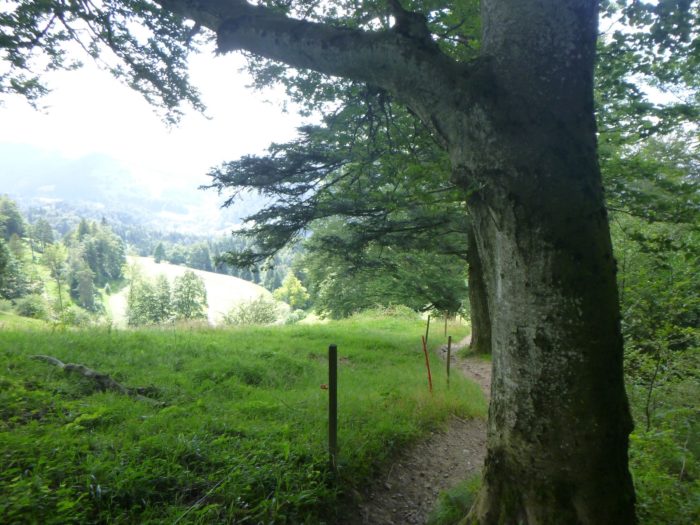 |
| Further down, just around a bend, the road appears, winding towards the antenna, wrapped around the meadows like a ribbon of black asphalt. Steg in the Tösstal, a sleepy village nestled in the valley, seems to recede as you approach, like an inaccessible mirage to the eye of the hiker. |
 |
 |
| Continuing on such a path, without the support of trekking poles, feels like true agony. Every step is a struggle, every movement calculated to avoid a fall. The cattle fence posts become unexpected allies, and sometimes, it is the strength of a rough trunk that prevents you from toppling into the abyss. The joints cry out in a blend of pleasure and pain, while the slippery stones threaten to topple the precarious balance into the chaos of the descent. |
 |
 |
| A little lower, an unexpected pause allows you to catch your breath before the perilous adventure resumes. In Switzerland, when you see the red and white marks, they are not signs for long-distance hiking trails. These marks, both discreet and formidable, warn you that you are on a difficult trail, reserved for those who are not faint of heart. But there is nothing dangerous here. |
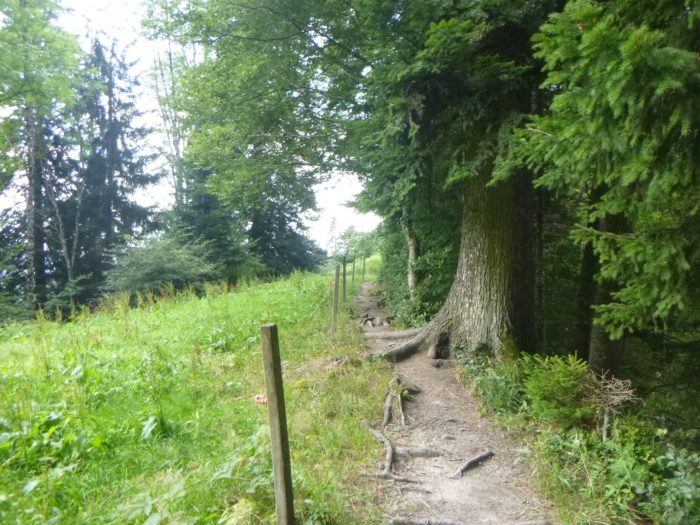 |
 |
| You are then thrust, like an intrepid tightrope walker, onto a winding trail plunging into a dense forest, where the young beech and stunted maple saplings struggle for a bit of light. Sometimes, the old, majestic beeches, pines, and spruces stand tall, powerful and stoic, offering support to those who dare to brush against them. And always this dizzying slope, challenging balance with its 20% to 30% gradient. |
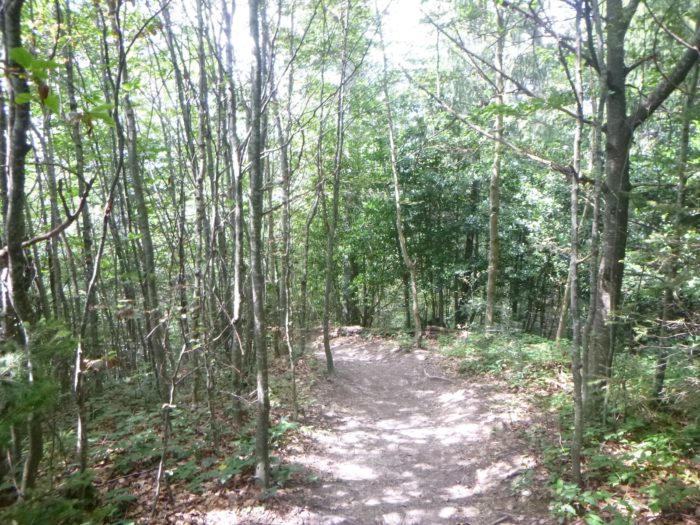 |
 |
| The route then becomes a game of skill, where you must outwit the traps set by gnarled roots and treacherous stones to progress unharmed. This march could have lasted for hours, so enveloping was nature’s embrace, seemingly intent on keeping you in its green cocoon. Yet, at one point, the undergrowth releases its hold, and the slope becomes gentler, as if the forest, magnanimous, is granting you a reprieve. |
 |
 |
| The trail then opens up to the fresh air, bathed in light, and before you unfolds a singing landscape, where wooded hills display their majesty under the brilliant sky. Nature itself seems to celebrate the end of your journey, chirping in harmony with the rustling of the leaves. |
 |
 |
At the bottom of this descent, which will undoubtedly leave its mark on you, the landscape reveals a wide expanse where the road winds in hairpin turns towards the Hörnli. On the slope, nestled in the arms of the mountain, lies the place known as Tanzplatz, a spot that, at first glance, seems much more than just a dance floor for festive evenings, holding within it the echo of ancient traditions and unsolved mysteries.

| Here, the wide dirt road curves gently, descending towards the vast plain stretching as far as the eye can see. But the Camino de Santiago, with its almost capricious adherence to the less obvious paths, avoids the major routes. It prefers the modesty of a barely marked trail, subtly winding along the ridge, like an invitation to rise above the everyday. This path, seemingly drawn by the fingers of nature itself, appears to float at the boundary between sky and earth, offering the pilgrim an unparalleled view. |
 |
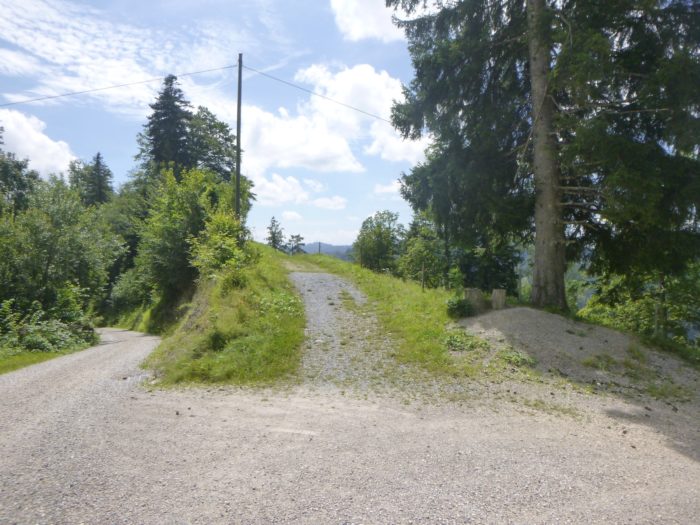 |
| The trail remains on the ridge, following the line of the treetops like a thread of Ariadne in a celestial labyrinth. It is one of those alpine landscapes where the soul finds an echo, where you feel connected to a nature stripped of all artifice, but which, in this simplicity, touches the divine. Each turn, each advance, reveals a perfect harmony between sky, mountain, and valley. Here and there, solitary benches offer a temporary refuge, a place to sit, let the gaze and heart wander, admiring the splendor of the heights that seem endless. |
 |
 |
| Then, inevitably, the trail inclines, and the slope becomes steeper. It plunges into the meadows with a gentle yet relentless determination, while the hamlet of Steg im Tösstal, previously hidden by the folds of the terrain, begins to grow, gradually coming into view of the hiker. |
 |
 |
| Arriving at the bottom, the trail rejoins the wide dirt road, like an old friend met after a long absence. It lingers there, following it for a few hundred meters, as if to rekindle the connection before resuming its solitary route. |
 |
 |
| But once again, it escapes, leaving the road to slip into the grass, sneaking towards a discreet woodland, barely visible to the untrained eye. There, under the benevolent shade of the trees, it seems to hesitate, caught between the comfort of the road and the serenity of the forest. But soon, it finds its way back to the road, like a red thread guiding the pilgrim inexorably. |
 |
 |
| However, true to its capricious nature, the path soon abandons the road once more. The cover of the trees irresistibly draws it in, offering a cool and welcoming shade. Here, it prefers the tranquility of a small trail winding under the branches, hidden from view, like a secret shared only with those who dare to follow it. |
 |
 |
| Yet again, the path grows weary of this shaded solitude. It retraces its steps to join the main road, one last time. In a bend, the landscape finally opens up, revealing without restraint the village of Töss im Tal, nestled in the valley, like a promise of arrival and rest. |
 |
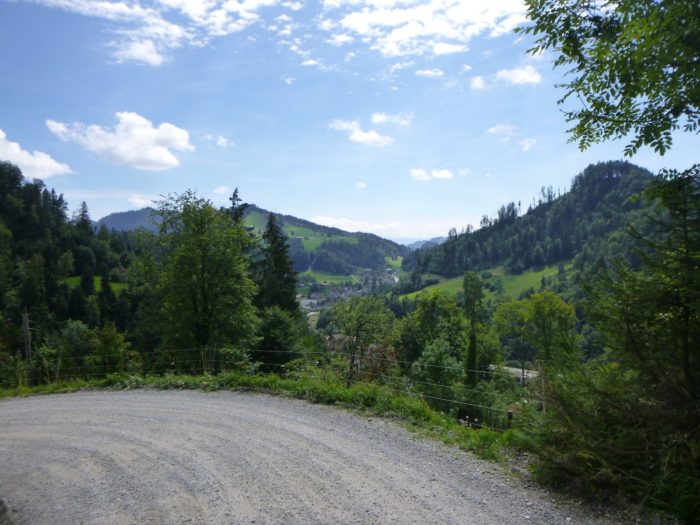 |
| The Via Jacobi then embarks on a series of switchbacks, following the curves of the dirt road winding through the forest. This winding descent, between shadow and light, gives the walker the impression of being drawn into the depths of the valley, where each turn reveals a new fragment of this mysterious and verdant landscape. |
 |
 |
| Further down, you emerge from this sylvan embrace to reach the village, where the road, now paved, gently brings you back to civilization. The contrast between the tranquility of the woods and the peaceful appearance of the first buildings enhances the feeling of a gradual return to the modern world. |
 |
 |
| Yet, true to its habit of avoiding overly obvious routes, the Via Jacobi offers a detour. A small parallel trail presents itself, inviting one last deviation before fully entering the village. This detour takes you across the Töss River on a small bridge, a delicate and charming passage where the water sings beneath your steps, as if to accompany your journey with its soothing murmurs. |
 |
 |
| The municipality of Fischenthal, which you now tread upon, is a haven of nature, encompassing the three villages of Steg im Tösstal, Fischenthal, and Gibswil. Here, life seems to flow more slowly, sheltered from the hustle and bustle of large cities. With only 2,700 inhabitants, the municipality is sparsely populated, and the serenity that prevails is almost palpable. The scattered chalets bear witness to this harmony between man and nature, where each dwelling seems to have found its ideal place in the landscape. |
 |
 |
Yet, this tranquility does not equate to isolation. The region, though rural, remains connected to the outside world. The train, a faithful companion of the locals, allows for a smooth journey to the valley, then to Winterthur, before reaching Zurich. Thus, even in this peaceful haven, the link with the major cities remains intact, offering the best of both worlds.

Accommodation on Via Jacobi
- Pension Räubergasse, Flurstrasse 3, Sirnach; 077 478 79 88/079 713 34 17; Guestroom, breakfast
- B&B Sirnach, Im Brüel 13, Sirnach; 071 966 30 89/076 572 94 01; Guestroom, dinner, breakfast
- Haus zur Orchidee, Untermattstrasse 29, Sirnach; 071 960 02 92/079 677 69 74; Guestroom, breakfast
- Hotel Happiness, Brüelhalde 1, Sirnach; 071 966 46 01/079 832 34 95; Hôtel, breakfast
- B&B Carole Moser, Fischingerstrasse 30, Oberwangen; 071 977 22 22/ 079 865 19 29; Guestroom, dinner, breakfast
- B&B Ester Amsler, Sägestrasse 5, Oberwangen; 079 677 69 74; Guestroom, breakfast
- Schwendi-Stübli Richard & Ursula Egg, Hinter Schwendi 42, Fischingen; 071 977 12 38; Guestroom, dinner, breakfast
- Kloster Fischingen, Hauptstrasse, Fischingen; 071 978 72 20; Hotel, dinner, breakfast
- Berggasthaus Hörnli; Hörnli; 055 245 12 02; Gîte, repas, breakfast
- Pilgerherberge Fischbach (paille), Fischbach 1, Steg in Tösstal; 055 245 15 25/079 522 68 29; Gîte, dinner, breakfast
- Famile Kägi, Aeaschgasse 17, Steg im Tösstal; 079 688 73 36; Guestroom, breakfast
There are slightly more accommodation options along this stage, even en route. In Fischingen, the cloister offers numerous available spots. However, options are fewer in Steg. You can also stay at the Hörnli, provided that the restaurant is open. Shops can be found along the route, particularly in Sirnach, Fischingen, and Steg. You can dine in Fischingen and further up at Au while heading towards the Hörnli Pass, where there is also a restaurant. Regardless of your destination, whether it’s the Hörnli or descending to Steg, it is crucial to book your accommodation in advance. The alternative is to continue further to Gibswil, where there is a lovely hotel-restaurant.
Feel free to add comments. This is often how you move up the Google hierarchy, and how more pilgrims will have access to the site.
|
 |
Next stage : Stage 4: From Steg im Tösstal to Rapperswil |
|
 |
Back to menu |









































































